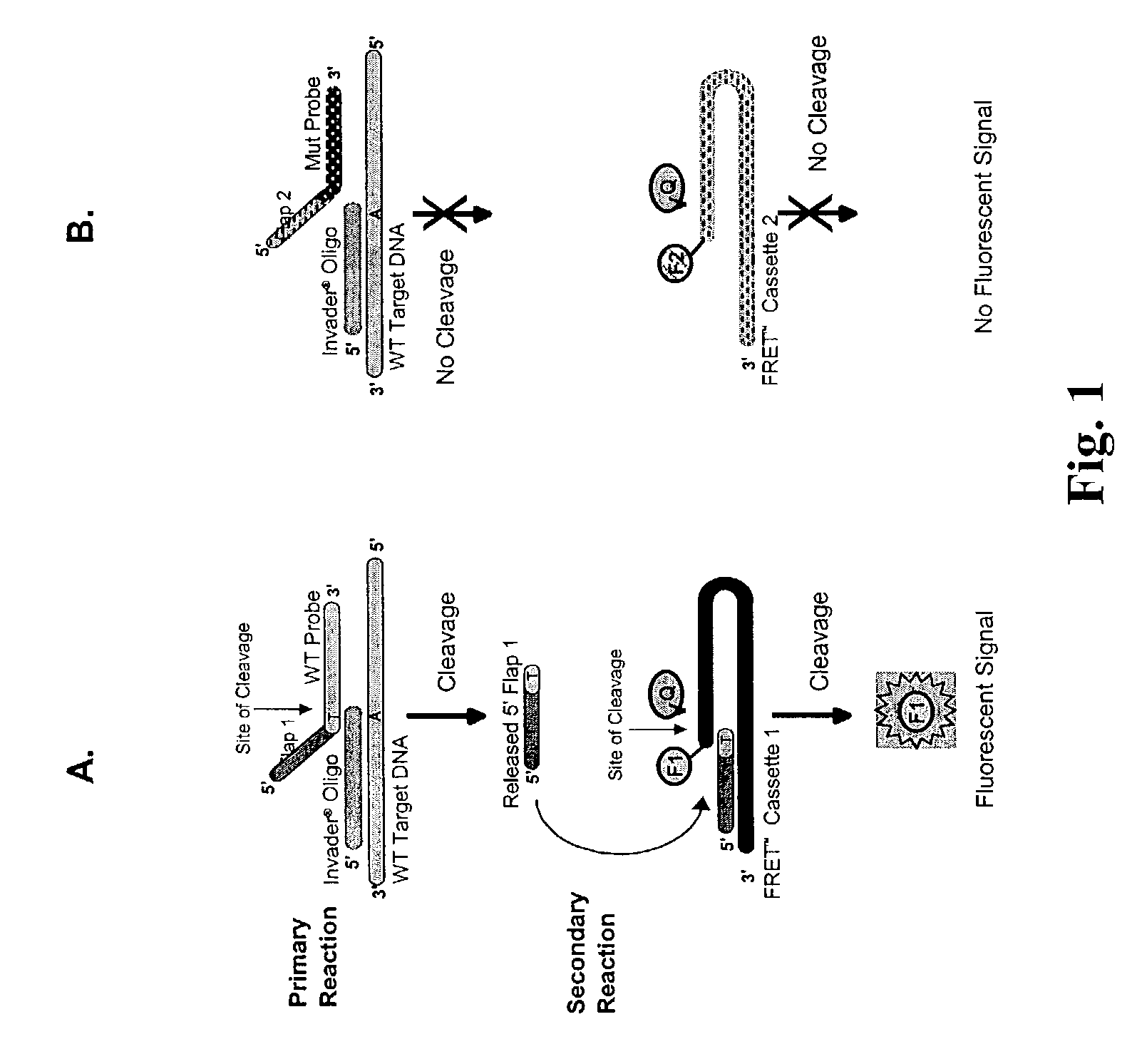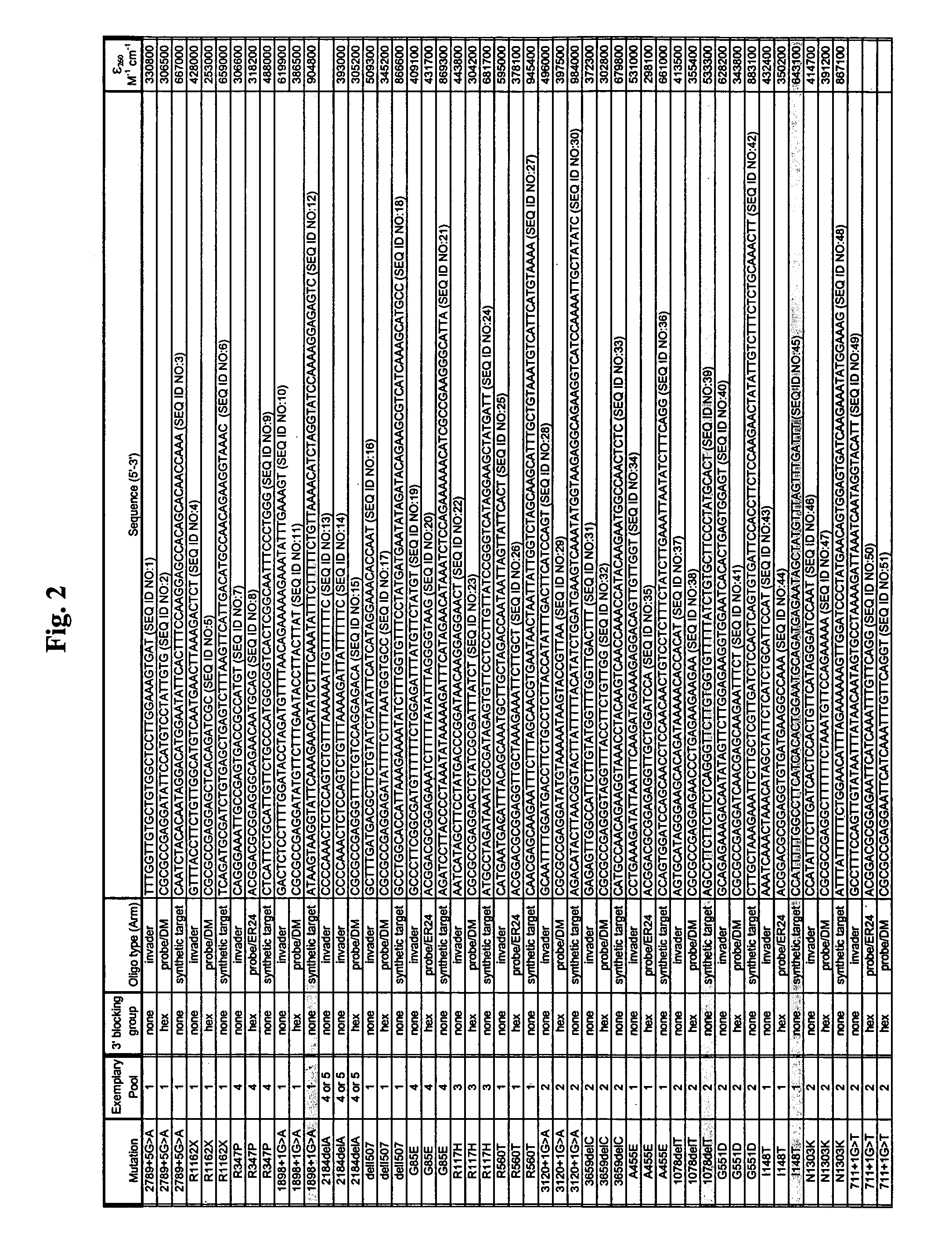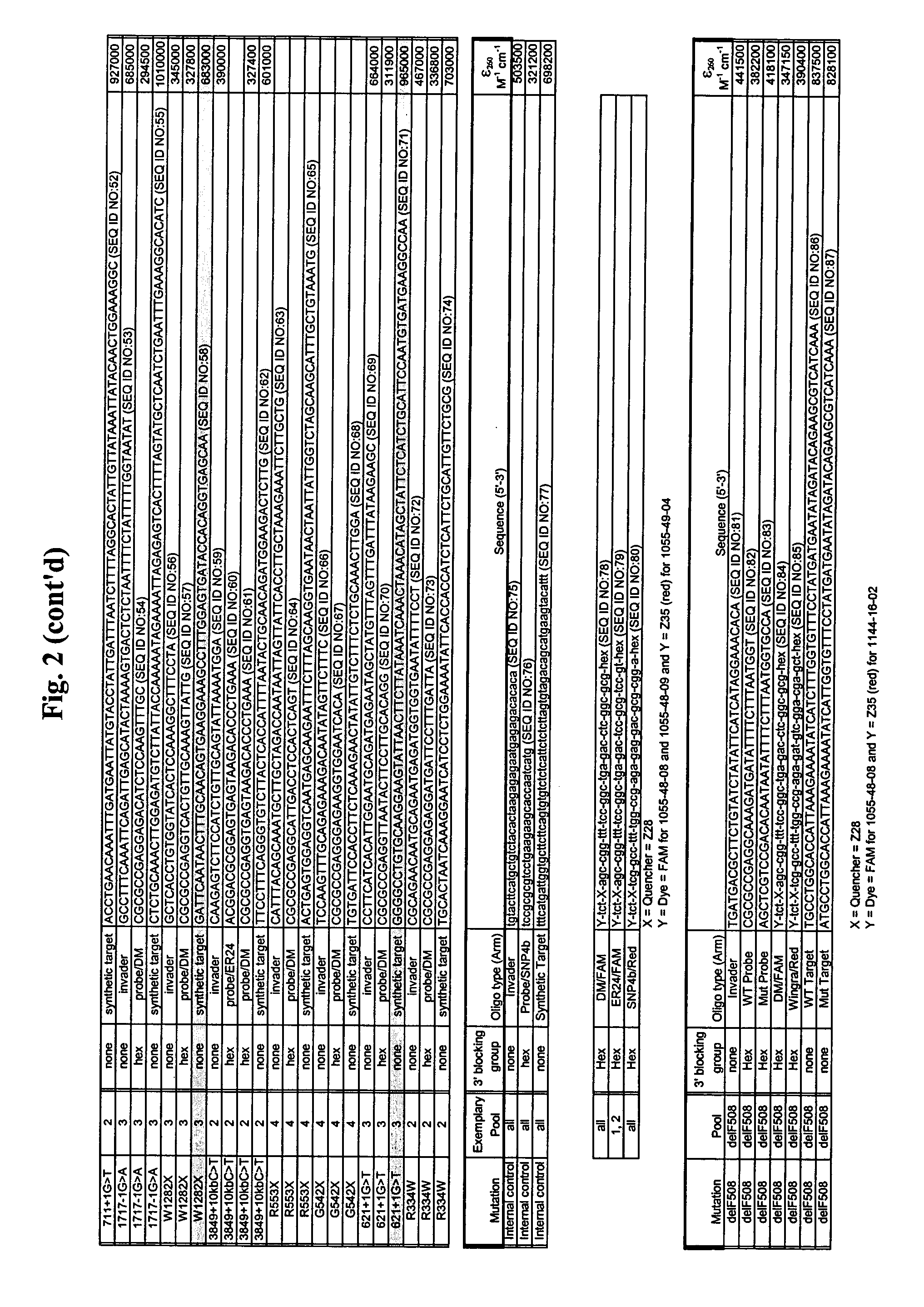CFTR allele detection assays
a technology of allele detection and assay, which is applied in the field of composition and methods for the detection and characterization of mutations associated with cystic fibrosis, can solve the problems of abnormal intracellular chloride levels, high morbidity, and reduced life span
- Summary
- Abstract
- Description
- Claims
- Application Information
AI Technical Summary
Benefits of technology
Problems solved by technology
Method used
Image
Examples
example 1
Reagents and Methods for Detection of Cystic Fibrosis Transmembrane Conductance Regulator (CFTR) Mutations
[0191]The following examples serve to illustrate certain preferred embodiments and aspects of the present invention and are not to be construed as limiting the scope thereof. Ex. (Example); Fig. (Figure); ° C. (degrees Centigrade); g (gravitational field); hr (hour); min (minute); olio (oligonucleotide); rxn (reaction); vol (volume); w / v (weight to volume); v / v (volume to volume); BSA (bovine serum albumin); CTAB (cetyltrimethylammonium bromide); HPLC (high pressure liquid chromatography); DNA (deoxyribonucleic acid); p (plasmid); μl (microliters); ml (milliliters); μg (micrograms); mg (milligrams); M (molar); mM (milliMolar); μM (microMolar); pmoles (picomoles); amoles (attomoles); zmoles (zeptomoles); nm (nanometers); kdal (kilodaltons); OD (optical density); EDTA (ethylene diamine tetra-acetic acid); FITC (fluorescein isothiocyanate); SDS (sodium dodecyl sulfate); NaPO4 (sodi...
example 2
Alternative Oligonucleotide and Pool Configurations
[0221]In another embodiment, alternative designs were created for some of the oligonucleotides, and some oligonucleotides were included in different pools. These alternative reaction mixes were applied to the analysis of samples as described in Example 1.
[0222]Reagents:[0223]CFTR (I148T) M1 Mut Control (1 vial marked “CA”, 250 μl)[0224]CFTR (1898+1G>A) M1 Mut Control (1 vial marked “CB”, 250 μl)[0225]CFTR (1078delT) M2 Mut Control (1 vial marked “CC”, 250 μl)[0226]CFTR (621+1G>T) M3 Mut Control (1 vial marked “CD”, 250 μl)[0227]CFTR (G542X) M4 Mut Control (1 vial marked “CE”, 250 μl)[0228]CFTR (2184delA) M5 Mut Control (1 vial marked “CF”, 250 μl)[0229]Control 4 (No Target Blank) (1 vial marked “C4”, 1250 μl)[0230]Cleavase® X / CF Enzyme or Cleavase Enzyme Mix (20 ng / μl, 1 vial, 1250 μl)
[0231]Reagent Composition:[0232]CFTR (2184delA) M5 Mut Control is a plasmid construct containing the 2184delA sequence suspended in yeast tRNA and buf...
example 3
Reagents and Methods for Detection of the ΔF508 Mutation in Cystic Fibrosis Transmembrane Conductance Regulator (CFTR) Gene in a Biplex Format
[0252]Reagents:[0253]CFTR (ΔF508) Control 1 (WT) (1 vial marked “C1”, 250 μl)[0254]CFTR (ΔF508) Control 2 (HET) (1 vial marked “C2”, 250 μl)[0255]CFTR (ΔF508) Control 3 (MT) (1 vial marked “C3”, 250 μl)[0256]Control 4 (No Target Blank) (1 vial, marked “C4”, 1250 μl)
[0257]Reagent Storage:[0258]Store at −20° C.
[0259]Reagent Composition:[0260]CFTR (ΔF508) Control 1 (WT), CFTR (ΔF508) Control 2 (HET), and CFTR (ΔF508) Control 3 (MT) are synthetic oligonucleotides suspended in yeast tRNA and buffered nuclease-free water. Control 4 (No Target Blank) contains yeast tRNA in buffered nuclease-free water.[0261]CONTROL USAGE:[0262]1. Determine the number (singlicate, duplicate, triplicate, quadruplicate) of controls to be tested. Use 10 μl of control material in each reaction.[0263]2. Treat control materials the same as test samples throughout the INVADE...
PUM
| Property | Measurement | Unit |
|---|---|---|
| temperature | aaaaa | aaaaa |
| temperature | aaaaa | aaaaa |
| concentration | aaaaa | aaaaa |
Abstract
Description
Claims
Application Information
 Login to View More
Login to View More - R&D
- Intellectual Property
- Life Sciences
- Materials
- Tech Scout
- Unparalleled Data Quality
- Higher Quality Content
- 60% Fewer Hallucinations
Browse by: Latest US Patents, China's latest patents, Technical Efficacy Thesaurus, Application Domain, Technology Topic, Popular Technical Reports.
© 2025 PatSnap. All rights reserved.Legal|Privacy policy|Modern Slavery Act Transparency Statement|Sitemap|About US| Contact US: help@patsnap.com



